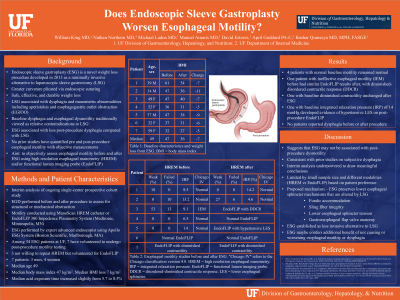Tuesday Poster Session
Category: Interventional Endoscopy
P4545 - Does Endoscopic Sleeve Gastroplasty Worsen Esophageal Motility?
Tuesday, October 29, 2024
10:30 AM - 4:00 PM ET
Location: Exhibit Hall E

Has Audio

William W. King, MD
University of Florida College of Medicine
GAINESVILLE, FL
Presenting Author(s)
Award: Presidential Poster Award
William King, MD1, Nathan Northern, MD1, Michael Ladna, MD2, Manuel Amaris, MD1, David Estores, MD1, April Goddard, PA-C1, Bashar Qumseya, MD, MPH1
1University of Florida College of Medicine, Gainesville, FL; 2University of California Davis School of Medicine, Sacramento, CA
Introduction: Endoscopic sleeve gastroplasty (ESG) is a novel weight loss procedure involving plication of the greater curvature via endoscopic suturing. It has been shown to be safe and effective in inducing durable weight loss. Unlike laparoscopic sleeve gastrectomy (LSG), ESG has not been associated with post-procedure dysphagia. We aimed to objectively assess esophageal motility before and after ESG using high resolution esophageal manometry (HREM).
Case Description/Methods: This is an interim analysis of an ongoing single center prospective study. Metrics were obtained before and six months after the procedure. We evaluated motility using high resolution esophageal manometry or endoscopic functional lumen imaging probe (EndoFLIP).
So far, four patients have had motility testing both before and after ESG. Three patients were male. The median age was 46. The median body mass index (BMI) declined from 47 to 35 in the first six months after the procedure. Among the two who underwent esophagogastroduodenoscopy (EGD) before the procedure, both had normal EGD findings both before and after ESG. The two remaining patients who did not undergo EGD before the procedure did not have any abnormalities on post-procedure EGD.
Three patients had normal HREM before ESG. Their HREM remains normal after the procedure. One had distal esophageal spasm both before and after ESG. No patient had a clinically significant change in proportion of weak or failed swallows or in distal contractile integral (DCI). None reported dysphagia.
Discussion: This interim analysis is underpowered but suggests that ESG may not be associated with post-procedure esophageal dysmotility. We propose two potential mechanisms – ESG preserves endogenous anti-reflux mechanisms including fundic accommodation, sling fiber integrity, lower esophageal sphincter tension, and gastroesophageal flap valve anatomy that can be altered by LSG, thereby preventing reflux-induced dysmotility. Secondly, preservation of gastroesophageal junction anatomy preserves peristaltic function.
ESG may thus offer several advantages over traditional LSG as a less invasive procedure preserving esophageal motility with lower risk of post-procedure dysphagia. Ongoing research will further explore this hypothesis.
Note: The table for this abstract can be viewed in the ePoster Gallery section of the ACG 2024 ePoster Site or in The American Journal of Gastroenterology's abstract supplement issue, both of which will be available starting October 27, 2024.
Disclosures:
William King, MD1, Nathan Northern, MD1, Michael Ladna, MD2, Manuel Amaris, MD1, David Estores, MD1, April Goddard, PA-C1, Bashar Qumseya, MD, MPH1. P4545 - Does Endoscopic Sleeve Gastroplasty Worsen Esophageal Motility?, ACG 2024 Annual Scientific Meeting Abstracts. Philadelphia, PA: American College of Gastroenterology.
William King, MD1, Nathan Northern, MD1, Michael Ladna, MD2, Manuel Amaris, MD1, David Estores, MD1, April Goddard, PA-C1, Bashar Qumseya, MD, MPH1
1University of Florida College of Medicine, Gainesville, FL; 2University of California Davis School of Medicine, Sacramento, CA
Introduction: Endoscopic sleeve gastroplasty (ESG) is a novel weight loss procedure involving plication of the greater curvature via endoscopic suturing. It has been shown to be safe and effective in inducing durable weight loss. Unlike laparoscopic sleeve gastrectomy (LSG), ESG has not been associated with post-procedure dysphagia. We aimed to objectively assess esophageal motility before and after ESG using high resolution esophageal manometry (HREM).
Case Description/Methods: This is an interim analysis of an ongoing single center prospective study. Metrics were obtained before and six months after the procedure. We evaluated motility using high resolution esophageal manometry or endoscopic functional lumen imaging probe (EndoFLIP).
So far, four patients have had motility testing both before and after ESG. Three patients were male. The median age was 46. The median body mass index (BMI) declined from 47 to 35 in the first six months after the procedure. Among the two who underwent esophagogastroduodenoscopy (EGD) before the procedure, both had normal EGD findings both before and after ESG. The two remaining patients who did not undergo EGD before the procedure did not have any abnormalities on post-procedure EGD.
Three patients had normal HREM before ESG. Their HREM remains normal after the procedure. One had distal esophageal spasm both before and after ESG. No patient had a clinically significant change in proportion of weak or failed swallows or in distal contractile integral (DCI). None reported dysphagia.
Discussion: This interim analysis is underpowered but suggests that ESG may not be associated with post-procedure esophageal dysmotility. We propose two potential mechanisms – ESG preserves endogenous anti-reflux mechanisms including fundic accommodation, sling fiber integrity, lower esophageal sphincter tension, and gastroesophageal flap valve anatomy that can be altered by LSG, thereby preventing reflux-induced dysmotility. Secondly, preservation of gastroesophageal junction anatomy preserves peristaltic function.
ESG may thus offer several advantages over traditional LSG as a less invasive procedure preserving esophageal motility with lower risk of post-procedure dysphagia. Ongoing research will further explore this hypothesis.
Note: The table for this abstract can be viewed in the ePoster Gallery section of the ACG 2024 ePoster Site or in The American Journal of Gastroenterology's abstract supplement issue, both of which will be available starting October 27, 2024.
Disclosures:
William King indicated no relevant financial relationships.
Nathan Northern indicated no relevant financial relationships.
Michael Ladna indicated no relevant financial relationships.
Manuel Amaris indicated no relevant financial relationships.
David Estores indicated no relevant financial relationships.
April Goddard indicated no relevant financial relationships.
Bashar Qumseya indicated no relevant financial relationships.
William King, MD1, Nathan Northern, MD1, Michael Ladna, MD2, Manuel Amaris, MD1, David Estores, MD1, April Goddard, PA-C1, Bashar Qumseya, MD, MPH1. P4545 - Does Endoscopic Sleeve Gastroplasty Worsen Esophageal Motility?, ACG 2024 Annual Scientific Meeting Abstracts. Philadelphia, PA: American College of Gastroenterology.

